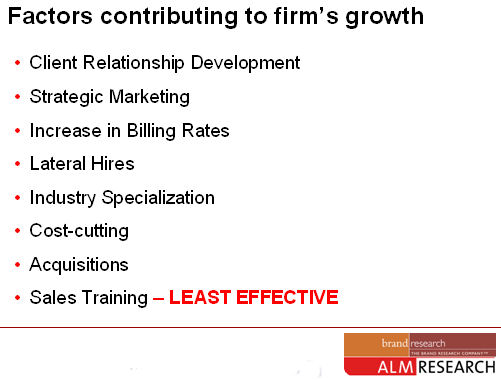
|
http://www.patrickmckenna.com/blog
Page << Prev 80 81 82 83 84 85 86 87 88 89 Next >> of 95
An Element of Tinkering (07/01/06)
 After years of watching American Lawyer magazine and others report profit-per-equity-partner (PEP) metrics, it is still hard to accept that there are highly intelligent lawyers who actually believe the numbers being reported. In fact, in some jurisdictions there has been a competition among firms to see which of them can go public with reporting the most outrageous increase in their profitability. After years of watching American Lawyer magazine and others report profit-per-equity-partner (PEP) metrics, it is still hard to accept that there are highly intelligent lawyers who actually believe the numbers being reported. In fact, in some jurisdictions there has been a competition among firms to see which of them can go public with reporting the most outrageous increase in their profitability.
NEWS FLASH: Any firm can manipulate their numbers, up or down (usually up), in any number of creative ways. Be skeptical.
The easiest way (in principle) to improve your firm’s PEP in an upcoming year is simply to reduce the number of equity partners. And, as many of those professionals who are de-equitized, tend to be senior level partners who have gone into retirement without formally notifying the firm, they are at the top end of the equity range such that their shares add more to the pot for fewer partners.
Another common area for tinkering is when you determine what specific major expenditures could be capitalized and what could be expensed against the current year’s revenues. Capitalizing a significant expense can be a good way to smooth out profit over a number of years.
If you want higher PEP you could simply change your firm’s policy on providing for unbillable disbursements and / or bad debt, You can make the firm’s figures look better in any given year. And what do you do with the money received from a new landlord for making improvements or the rent-free period obtained during an office move?
Then of course there is some judgment required in determining precisely how many equity partners your firm has. Do you take the number of equity partners in the offices at year end, or do you take an average during the course of the year, and what about adjustments for those partners who operate in other jurisdictions . . .
And, since most professional service firms are under no legal obligation to make their financial results public, when all else fails . . . choose whatever PEP numbers you like. As Peter Drucker once said, when you make up a number you put the onus on others to get to work and prove you wrong!
Goldman Sachs Is Clearly On Top Of The World (06/30/06)
And, according to a friend (who understands these high finance matters far better than I could ever) . . . it is a world rich in 'ations' - notice: financialization, globalization, securitization, and derivatization. The words are big and new. But the ideas are old and common. In short, it is a world that favors money shuffling and debt, over making things and saving money. After all, George Bush did not ask the president of General Motors to take the highest financial post in the country, secretary of the treasury. No, he turned to the alpha firm, the "biggest hedge fund in the world," Goldman Sachs.
Has an important financial deal been done in the last five years without Goldman's fingerprints on it? Is there any bond, mortgage, or I.O.U. in all the world that does not mention Goldman somewhere in the small print? Is there any speculation, derivative, or trade that Goldman has not done to excess? No! And that is why the New York firm is practically a living legend. Its innovations, connections, and ambitions helped turn America into Speculation Nation. And now, the credit bubble that Goldman helped to create threatens not only the world economy, but Goldman itself.
In the whole history from the beginning of United States of America to the dawn of the 21st century, the nation accumulated $ 5.7 trillion in gross federal debt. Six years into the sunny day of the new millennium - and now the figure is half-again as much. In those same first years of this century, U.S. mortgage debt rose by an additional $3 trillion, much of it in diabolical ARMs (adjustable rate mortgages), where payments go up after the teaser rates expire.
Meanwhile, Goldman's worldwide trading has helped stimulate and facilitate insolvency at home and abroad. When a big corporation - or even a sovereign nation - wants to borrow money, to whom does it turn? Goldman, of course. And it lured the world's richest nation, with a modest net asset position with the rest of the world, equal to 5% of GDP in the '80s, to become the world's biggest debtor, with a negative net asset position equal to 20% of GDP.
And now, the U.S. householder faces a double problem. Interest rates are rising. And so are his mortgage payments. More than $1 trillion worth of ARMs are scheduled to be ratcheted up this year. And another $1.7 trillion next year. Plus, the government, which also funded its spending with short-term financing at low rates, now must refinance trillions worth of its bonds at higher ones. My friend says, “No wonder they called Hank Paulson to the U.S. Treasury Department.”
The Tribe Has Spoken (06/23/06)
Apparently this comes from a survey of 157 law firm Marketing Directors conducted between November 2005 and January 2006 to determine what specific factors most contribute to a firm’s revenue growth -
and the legal marketing consultants (especially those who try to sell Sales Training) just hate the implications.

For my part, I think that it is about time that someone started measuring precisely what works, and what doesn’t!
 Stupid Consulting Tricks (06/16/06) Stupid Consulting Tricks (06/16/06)
It is always fascinating the degree that some consultants will go to prospect for business.
One consultants’ marketing technique is to make up the name of a client, in this case another firm in your profession. He then calls you, as the managing partner of your firm, to ask for 15 minutes of your time to interview you. He purposely uses a novel term, like ‘rumor due diligence,’ designed to appeal to your curiosity.
I have not heard back from you regarding your availability for a "rumor due diligence" interview regarding certain firms in your city. I remain open tomorrow. Please let me know if I can have 15 minutes of your time. Again, thanks in advance for your participation and assistance.
When he finally connects with you, he gives you a little dog-and-pony about how his client, say a major Los Angeles firm, is looking to do a deal / merge / acquire a firm in your city as his client has lots and lots of business to send your way. He declares that your firm is one of a handful that he is interviewing.
And all of this should serve to remind us both that it is time to take one of our anti-idiocy pills that don't seem to be working, and that, for reasons that highly-trained psychiatrists don't even want to address . . . if you express interest and want to be considered, this consultant reverses the process and goes shopping in Los Angles to find some firm that might be interested in merging with a firm in your city!
Stop With The Voodoo Management (06/15/06)
Heroic leaders are a disaster. In most firms, financial incentives cause more problems than they solve. Leaders do make a difference, but not as much as you might think, and more on the downside. Yes, strategy and recruiting good talent is important . . . but strategy is usually overrated, to the detriment of implementation . . . and overestimating raw talent can impede learning. It's no use putting good people to work in a crappy system; conversely, putting people in a good system and expecting them to improve increases their individual and group capabilities. The main goal of too many consultancy assignments is another consultancy assignment. All 'silver bullet' or 'big ideas' on their own are wrong!!!
These are not theories, but FACTS. Yet firms trip over themselves to launch change initiatives, introduce pay for performance, flit from one big idea to the next such that Hard Facts, Dangerous Half-Truths and Total Nonsense (Harvard Business School Press), by Stanford professors Jeffrey Pfeffer and Robert Sutton, is a compelling tour of management conventional wisdom and why it so often turns out to be unwise, untrue and a stranger to fact. Every potential manager should be made to read this book, shotgun to their heads, before they are allowed to be in charge of anything.
It is a weird paradox. Despite management's normal obsession with hard numbers, too many firms are swirling with untested assumptions. Horrifying sums of money are committed on superstition or whim. Thus, fact-based management is really triple-distilled common sense. It's hard. It requires judgment, practice, help, humanity and wisdom. It needs skepticism and experimentation. It needs reasoned optimism and learning, and, as F Scott Fitzgerald put it, the ability to function while holding two contradictory ideas in your head at the same time.
I LOVE Pfeffer and Sutton’s work, either together or individually, and this text is fabulous.
Playing The Game (6/09/06)
One of the ways we learnt as we were growing up was by playing games. A well conceived game strikes an important balance between being simple enough to comprehend quickly but with enough variables to captivate your attention.
If we think about your firm as a game, what insights can we gain as a leader? Consider that you must begin by defining how you see your role as the leader to:
• Understand and define the game – what winning looks like and how it is accomplished
• Comprehend the different strategies that could be applied to compete most effectively
• Assemble a complete team to execute the chosen strategy
• Make sure each player understands the strategy and how their role interacts / connects with other team members
• Energize and inspire the team to play an extraordinary game
• Create an environment for accelerated learning to refine and adapt the strategy over time.
What Is Your Competitive Advantage? (5/26/06)
 Prospects need to know what makes you and your firm special. Every law firm professes to have years of experience, be responsive and provide exceptional service – so once we’ve exhausted the clichés, what’s left? Prospects need to know what makes you and your firm special. Every law firm professes to have years of experience, be responsive and provide exceptional service – so once we’ve exhausted the clichés, what’s left?
Your advantage should be quantifiable. Talk about the total number of clients served, total value of transactions, dollars saved, success rates, clients satisfied and provide impressive metrics to back up any assertion. Example: Our lawyers have handled more than ‘X’ commercial real estate transactions, at a total value of over $’Y’ during the past Z years.
Tout your star qualities. Provide a list of client testimonials. Prospects feel more secure with a firm widely acknowledged by their peers.
Identify an attribute that isn’t claimed by a competitor. Let’s say you serve a large number of women entrepreneurs. Even if your competitor does the same, claim it first and claim it loudly. Firms hate looking like copy-cats so you are likely to preempt their ever taking action.
Develop a proprietary solution. Make a list of your added-value methodologies, approaches, actions and / or those technology answers that serve to make your client’s job (or lives) easier (or more profitable).
Your goal is to come up with a hard list of advantages to answer the prospect that asks, “Why should I choose your firm, what makes you distinctive and what specifically do you offer that I cannot get anywhere else?” And don’t kid yourself, if they’re not asking you this question, they’re definitely thinking it!
Are You Being Mentored? (5/15/06)
A thank you to David Maister for this kind note on his Blog.
 The concept of being mentored sounds like something that happens to you when you're young and on the way up. The truth, however, is that, at any age or stage, we all need a loving critic, a friendly skeptic, a coach, a mentor to help us make sense of the world. The concept of being mentored sounds like something that happens to you when you're young and on the way up. The truth, however, is that, at any age or stage, we all need a loving critic, a friendly skeptic, a coach, a mentor to help us make sense of the world.
The best way to think of a mentor is as someone who will be your confidante and guide. Someone you can go to in order to try out ideas, get feedback and advice . . .
. . . sources of mentors can be colleagues with whom you have previously worked. (I owe a significant debt of gratitude to Charlie Green and Patrick McKenna, previous co-authors, who, to this day, still take the time to preview my writing and make suggestions. I try to do the same for them.)
Zeal and Zest (5/12/06)
 Four factors that generate zeal and zest: Four factors that generate zeal and zest:
“VALUE”, as in: creating new value for our clients
Unique, different
Distinctly better
Special
Bold, breaks new ground
Compelling, exciting
Simple, clear
Matters: Clients believe we make their lives easier, better, more efficient, more effective, more productive, more meaningful, more fun—in a way that nobody else does, or in a way that is head and shoulders above what anyone else does. In other words, “value” goes beyond traditional buzzwords like “excellence” or “quality”
“SOUL”, as in: truly embedded in our firm’s persona:
Who we are
What we stand for
How we are (towards clients, plus what we expect from clients)
Business we seek, work we turn away
“Picture” and “Persona” that we all rally around
“INTEGRITY”, as in: walking the talk in execution:
Foundation for strategic, operational, budgetary and personnel decisions.
Live it, own it, we’re “true” to it
Delivery of service promised and client experience guaranteed.
“LEGACY”, as in:
What noble impact does our firm have on our marketplace?
What mark does our firm leave?
How do we change the world?
Articulate “Stretch” Goals (4/28/06)

Incremental goals fail to bring out the best in law firms or partners. “Make no small goals,” the old saw goes, “for they lack the power to stir our souls.”
Subscribe to radical goals. Imagine what might occur if you declare to your partners that you want to achieve a 35% growth in revenues-per-partner over the next two years. Then asked them to come forward with ideas as to how you could make that happen.
In one firm, the managing partner decided she wanted to survey every member of the executive committee prior to an important meeting. Using a questionnaire, she asked each of them their views of what might constitute a reasonable expectation for the firm’s future growth prospects. In the questionnaire she distributed, she told partners, “our profits-per-partner have increased during the past five years at an average rate of around 4.2% per year. What do you believe is an acceptable annual rate of growth in profitability over the next five years?”
What she did not disclose was that 6.2% was not the real number, and in fact, the 6.2% quoted was somewhat less than the actual results achieved. Quite predictably, based on the information this managing partner provided, nearly all of her partners responded that they would be quite happy to realize a level of 6 to 7% growth over the next five years.
Be Warned. The evidence is irrefutable. No organization ever outperforms its aspirations. Our beliefs set the upper limit on what is possible.
Page << Prev 80 81 82 83 84 85 86 87 88 89 Next >> of 95
|
|


 Ashridge House
Ashridge House  11226 - 60 Street
11226 - 60 Street  Edmonton, Canada
Edmonton, Canada  T5W 3Y8
T5W 3Y8